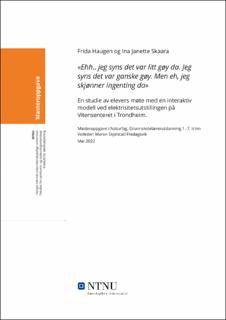| dc.contributor.advisor | Fredagsvik, Maren Skjelstad | |
| dc.contributor.author | Haugen, Frida | |
| dc.contributor.author | Skaara, Ina Janette | |
| dc.date.accessioned | 2022-07-14T17:21:14Z | |
| dc.date.available | 2022-07-14T17:21:14Z | |
| dc.date.issued | 2022 | |
| dc.identifier | no.ntnu:inspera:112394240:37321862 | |
| dc.identifier.uri | https://hdl.handle.net/11250/3005603 | |
| dc.description.abstract | Studiens hensikt er å undersøke hvordan en interaktiv modell i elektrisitetsutstillingen på Vitensenteret i Trondheim kan bidra til å skape engasjement og læring blant elever på 6.trinn. Vitensentre betegnes som populærvitenskapelige opplevelses- og læringssenter for barn og unge, med formål om å øke interessen for realfag og teknologi. Vitensentrene i Norge skal også fungere som ressurser til den vanlige opplæringen, og kan bidra til tilpasset opplæring gjennom å være en alternativ læringsarena. Kunnskapsdepartementet har utformet retningslinjer for de regionale vitensentrene i landet, og sier blant annet at sentrene skal være oppdaterte etter nye læreplaner.
Studien blir gjennomført som en kasusstudie og vi benytter oss av en metodetriangulering for å samle inn data. Lyd- og videoopptak av 8 elever som jobbet med modellen, gir oss kvalitative data. I tillegg gjennomfører vi en spørreundersøkelse som flere elever på mellomtrinnet skal svare på, noe som gir oss kvantitative data. Problemstillingen og forskningsspørsmålene blir analysert gjennom en tematisk og en statistisk analyse med en deduktiv tilnærming. Vi tar utgangspunkt i to ulike rammeverk for å se etter tegn på engasjement og læring. Studien i sin helhet baseres på et teoretisk grunnlag som inkluderer et sosiokulturelt og konstruktivistisk læringsperspektiv, læring i vitensenterkontekst og interaktive modeller.
Problemstillingen for denne oppgaven er, «Hvordan klarer utstillingsmodellen om elektriske kretser å skape engasjement og læring blant 6.trinnselever?», med følgende forskningsspørsmål:
1. På hvilken måte engasjerer modellen elevene?
2. Hvordan kommer elevers læring til syne når de jobber med modellen?
3. Hvilke endring av modell kan gjøres for å skape engasjement og læring?
Resultatene fra studien viser at den interaktive modellen om elektriske kretser lykkes i å skape mye fysisk engasjement blant elevene ved at den gir mange muligheter til å berøre modellen. Ved at elevene samarbeider om å jobbe med modellen bidrar dette også til et sosialt og emosjonelt engasjement. Samtidig viser resultatene at modellen har utfordringer med å bidra til læring. Modellen forutsetter at de besøkende innehar en del forkunnskaper om elektriske kretser for å kunne forstå oppgaven. Plakaten tilhørende modellen gir heller ikke så mye støtte som kanskje tiltenkt. Basert på disse funnene har vi kommet frem til noen forslag til endringer som kanskje kan være med på å øke læringsutbyttet til besøkende. En av disse endringene er blant annet å revidere plakaten til å treffe en større målgruppe. Sett i lys av resultatene våre opplever vi at Vitensenteret har lykkes i å skape en modell som engasjerer. | |
| dc.description.abstract | The purpose of this study is to investigate how an interactive model in the electricity exhibition at the Science Center in Trondheim can lead to engagement and learning among students in 6th grade. Science centers are described as popular scientific learning centers that emphasize a hands-on approach for children and youth. Their purpose is to increase interest in science and technology and can be used as a resource to complement the regular education. The Ministry of Education and Research have made guidelines for the regional science centers in Norway, and say, among other things, that they must be updated according to new curricula.
The study is conducted as a case study, and we use mixed methods to collect the data. We obtain the qualitative approach through audio and video observations of 8 students working with the model. In addition, we conduct a survey that several middle school students must answer, which gives us quantitative data. The main research question and the research sub-questions are analyzed through a thematic and a statistical analysis with a deductive approach. We use two different frameworks to look for signs of engagement and learning. The study is based on a theoretical basis that includes a social and constructivist learning perspective, learning in a science center context and interactive models.
The main research question for this thesis is, “How does the exhibition model about electrical circuits manage to create engagement and learning among 6th grade students?", with the following research sub-questions:
1. In what way does the model engage the students?
2. How do students learning become visible when they work with the model?
3. What changes to the model can be made to create engagement and learning?
The results from the study show that the interactive model of electrical circuits succeeds in creating a lot of physical engagement among the students by offering many opportunities to touch and work with the model. By having the students collaborate when they work with the model, we create a context that contributes to a social and emotional aspect of engagement as well. At the same time, the results show that the model has challenges in contributing to learning. The model implicates that the visitors need to have some prior knowledge of electrical circuits to understand the core of the task. The poster that is connected to the model does not provide as much support as might intended. Based on our findings, we come up with some suggestions for changes that may help increase the learning outcome for visitors. One of these changes is to make changes the poster to increase the target group. Considering our results, our experience is that the Science Centre succeeds in creating a model that engages. | |
| dc.language | nob | |
| dc.publisher | NTNU | |
| dc.title | «Ehh.. jeg syns det var litt gøy da. Jeg syns det var ganske gøy. Men eh, jeg skjønner ingenting da»
En studie av elevers møte med en interaktiv modell ved elektisitetsutstillingen på Vitensenteret i Trondheim. | |
| dc.type | Master thesis | |
